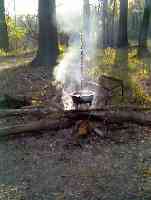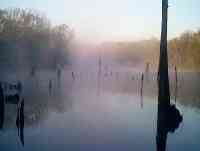|
My tale-tellin' buddy Dennis Dezendorf's Frugal Outdoorsman article "Reloading On The Kitchen Table" reminded me of my long-held desire to load bullets in a tent. As I had developed a hog load with cast bullets for my 30-30 Winchester Model 94 and planned a hog hunting camping trip using that load, I decided to put together a kit similar to Dennis's and take it with me. If he could reload ammo on the kitchen table of an apartment, I could reload ammo in a tent.
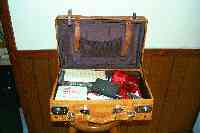
Photo by Dennis Dezendorf. An apartment reloading kit.
|
On the right, see Dennis's reloading kit, neatly packed in a leather attache case. I wanted a smaller kit. His contained most of his reloading equipment, but I decided mine should contain just the basics. All I needed were supplies and equipment for loading one load for one caliber. I wanted it all to fit in a bag small enough to tie to a horse. Not that I had a horse, but somewhere out there in Internet land there's a fellow with a pack horse wondering how much stuff he'd need if he wanted to reload in the wilderness.
I needed:
- bullets
- powder
- primers
- fired cases
- as few loading tools as possible
Looking over the ashes of my campfire, here's me holding my kit. It's a black canvas bag about the size of a basketball. It holds every item listed and shown below with plenty of room left over. Packed for tent reloading, it weighs 7 lbs.
In the center of the photo and with her head up and looking at the camera, see Suzy my hog dog. She'd had a long night of barking at boogers and a morning of traipsing through the woods after hogs. In other words, she refused to get out of her comfortable bed and pose for a photo.
Here's the kit unpacked and with its contents spread across my sleeping bag.
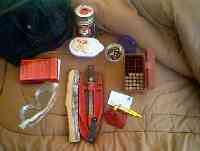 |
-
At 11 o'clock, see the black kit bag.
-
At 12 o'clock, that's a 1 lb can of H4198, and in front of it an oval, 11 oz plastic food container with a box of primers on top.
-
At 1 o'clock sits a round, 4 oz plastic food container filled with un-sized Lee C309-170-F cast bullets lubed with Lee Liquid Alox and with gas checks hand seated.
-
At 3 o'clock is an MTM CASE-GARD 50® containing about 25 fired 30-30 cases, neck down. The CASE-GARD did double-duty as a loading block, cases neck up.
-
At 5 o'clock is a business card, Lee 1.3 cc and .5 cc dippers, and a powder funnel.
-
At 6 o'clock is a Lee Hand Press with a Lyman seating die installed. Beside it is a stick of stovewood with a crude handle carved in camp with a hatchet.
-
At 7 o'clock sits a pair of safety goggles used while seating primers.
-
The red box at 9 o'clock is a Lee Loader in caliber 30-30.
And that is everything needed to load one load for one caliber in a tent. I don't care if it's raining or if snow is butt-deep outside and you're 20 miles from nowhere, you can use that stuff and load bullets in a tent.
Let's start loading. I began by de-priming the cases with the Lee Loader tool. I like its de-priming method because it does nothing to the case but de-prime it.
Here you see me de-priming a case using the chunk of stovewood as a hammer and using a stick of firewood as a bench.
In the background, see my homemade tent wood heater made from two small freon bottles. There's coffee in the pot, and the foil you can barely see behind it contains barbeque link sausage getting warm for lunch. I won't reveal my flue or flue-to-tent-wall gasket design for lawsuit reasons. I'll just note that the first 4 feet of flue pipe is a vehicle drive shaft. And I'll also note that my first flue pipe design melted when I built a roaring motor oil test fire in the heater.
You don't need a special tool for cleaning primer pockets, especially in a tent in the wilderness. The de-capping pin of the Lee Loader tool works just fine. Like you see me doing in this photo, run it around the inside of the primer pocket a couple of times, then blow out the debris.
Since I could load these cases as-fired, I skipped the neck sizing step. Here I'm seating a new primer with the Lee Loader tool. And I'm wearing the safety goggles. If you don't use safety goggles when seating primers with any tool, you're playing Russian roulette with your eyesight.
Here, I'm measuring powder with a Lee dipper. Note the CASE-GARD® used as a loading block. Note the plastic food container used as a powder container (for dipping only). You can get ± .1 gr accuracy with Lee dippers if you do the following:
-
Keep the powder container full or nearly full of powder.
-
Stroke the dipper through the powder the same every time.
-
Using a business card, etc., wipe off the little hill of powder from atop the dipper the same every time.
I used 1.3 cc + .5 cc dipper = 1.8 cc of powder because that combination gave me an average weight of 21.2 grs of H4198 with my lot # of powder and under my conditions. That load gave me average velocities of 1760 fps. Note: due to humidity differences alone, 21.2 grs of any gunpowder in dry Arizona contains more powder than 21.2 grs of that same powder in humid Louisiana. However, 1.8 cc is the same everywhere, even Texas.
In this photo I'm using the Lee Hand Press and Lyman seating die to (1) seat the bullet, and (2) crimp the bullet. As my 30-30 is a lever action, I must crimp the bullets. I don't like the crimping method of the Lee Loader or I would use it and eliminate the Lee Hand Press and Lyman die from my kit. If you don't need a crimped bullet, use just the Lee Loader and enjoy extra space in your kit.
You could also use just the Lee Hand Press and a set of regular reloading dies and eliminate the Lee Loader. The advantage there is being able to full-length resize cases. I don't know how it works with other, bigger cases, but it full-length resizes my 30-30 cases just fine. But, then, you'd have to add a tube of case lube to your kit.
Over on the right, there it is: my first genuine tent-loaded 30-30 round—directly from the wilds of north Louisiana.
I finished loading the remaining cases and filled my rifle's magazine with fresh, tent-loaded rounds—time for hog hunting.
Some would say a 170 gr lead 30-30 bullet at 1760 fps is light for hogs, but I must disagree, especially at 150 yards range max and 50 to 75 yards range likely. A few writers even call for using magnum calibers on hogs. Horse hocky, I say.
Until November, 2001, the area I hunted in LaSalle Parish, Louisiana, was open range. Cattle and hogs moved freely. If you didn't like cattle or hogs getting in your yard or garden, fix your fence. Robert Frost said it best in a poem titled "Good Fences Make Good Neighbors."
Hog owners, including myself, my grandfather, my great-grandfather, and my great-great-grandfather, ear-marked their hogs and hunted them by horseback with dogs. In my case, by Jeep. The preferred rifle in the early days was a Model 92 Winchester in caliber 32-20. Later, many hog owners bought or converted their Model 92s to .357 magnum.
I preferred a Rossi Model 92 copy in .357 magnum. My load was the Lee 140 gr 358-140-SWC at 1500 fps. That rifle and load killed many hogs. As best I can remember, it never required more than one shot.
Key #1 is to use a rifle capable of a fast second and even third shot; thus the lever action Model 92 and 94. Key #2 is to take head shots only, if possible. The skull of a 300 lb boar is no thicker than the skull of a 100 lb deer. But evolution gave wild boar hogs armor plating on their shoulders. When two boars fight, they wheel in a circle and rake their knife-blade-like bottom tusks against each others' sides. Thus the skin on their sides is thick and tough, and beneath that skin is a layer of gristle—all designed to keep an opponent's tusk from reaching muscle tissue and major blood vessels.
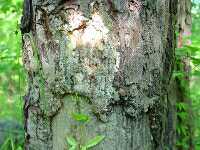
An Alpha boar's rub tree.
|

A close up showing a black hog hair in the rosin.
|
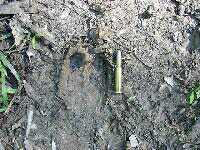
His track beside a 30-30 round loaded with a WW alloy Lyman 311041 over 26 grs of Varget (1.9 cc) for 1750 fps. As you can see, he's a big one. |
To top that off, north Louisiana wild boars use their tusks to scrape the bark off pine trees. When the sap starts oozing from the injured pine, the boars rub their sides against the ooze. It collects in their hair in a thick, resinous mat—a real armor plate. It's easy to detect the presence of an Alpha male hog in your neck of the woods. Look for pines with a large chunk of missing bark from just above ground level to about two feet above ground level. Look closely and you'll find hair in the ooze on the side of the tree.
He'll visit that pine tree scrape every day or two. If you plan to wait for him, you better know a few facts:
- He's a dangerous animal, as capable of killing you and eating you as a grizzly bear.
- You better have a fast second shot.
- Aim for his head.
- If you absolutely must aim for his body, you better hope your bullet makes it through that armored side and into his chest cavity.
Most people go wrong by using a bullet designed for whitetail deer. It easily penetrates the side of a sow or domestic boar or young wild boar, but when it hits the armored side of a mature wild boar it expends all of its energy on hide and gristle and blows a hole in the side of the boar. He may run and live to fight again, but he may also die a horrible and lingering death. And he may decide to give you a horrible and lingering death.
So use a heavily-constructed bullet. A bullet cast from wheelweights works just fine, even at moderate velocities.
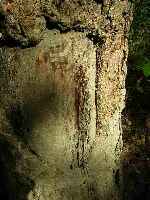
Photo taken June 6, 2005. Another boar scrape about 1/4 mile from the one above. Notice in the bare spot, caused by logging damage several years earlier, the upward, circular marks left by the boar's tusk as he sliced the tree. The black ooze is rosin. The boar will return soon and rub his side in that rosin to reinforce his shield. |
|
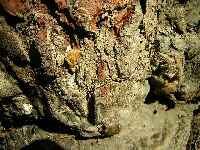
A close up of the NW corner of the photo on the left. It shows black hog hair caught in bark, and it shows tusk damage to bark. Trust me—you don't want that tusk working on your leg or your dog's belly.
|
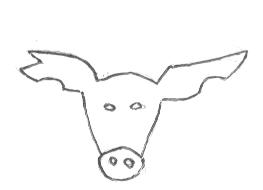 Here's a drawing of my grandfather and great-grandfather's hog mark. To an open range hog man, it reads: upper slope and under bit in the left ear, swallow fork and under bit in the right ear. Cuts I remember include:
Here's a drawing of my grandfather and great-grandfather's hog mark. To an open range hog man, it reads: upper slope and under bit in the left ear, swallow fork and under bit in the right ear. Cuts I remember include:
- upper and under slope
- upper and under bit
- crop
- upper and under 1/2 crop
- swallow fork
- split (horizontal)
- upper and under split (vertical) also called "hack"
- upper and under figure 7
I'm sure there's more I can't remember, but combinations of those cuts gave a huge number of marks. North Louisiana parish courthouse records still contain old brand and ear mark books. Brands and ear marks were filed in the courthouse and bought and sold just like land. When you bought a brand or ear mark, you also bought all the cattle and hogs in the woods with that brand or mark. Around 1970, my dad sold the hog mark shown above for $100.
There's a point to my giving you all this information about open range and hog marks. There's still many marked hogs in the woods of LaSalle Parish and other parishes and counties even though the open range days are over. A marked hog has an owner—who probably has proof of ownership on file at the courthouse.
Yes, the owner is in violation of the stock law by letting his hog run free. But all he has to do is say, "That hog broke out of the pen last week, and I've been huntin' it ever since." Violation of the stock law is a misdemeanor.
If you shoot that hog, you, however, clearly violate a law titled: Theft Of Livestock—a felony. You will (1) go to jail; and (2) you will reimburse the owner for the value of his hog. And that mangy, wild, and $20 hog will suddenly become a child's pet—raised on a baby bottle in a box beside the kitchen stove. And the owner will say, "I wouldn't've sold that there hog for $1,000."
All the above has happened many times in LaSalle Parish.
 Here's a photo taken in July, 1999, of an open range, marked sow and her unmarked piglet.
Here's a photo taken in July, 1999, of an open range, marked sow and her unmarked piglet.
She has cuts I can't read, but I can see an under bit in her right ear and a crop in her left ear.
While we're looking at the picture of the open range sow, notice how differently she looks from pictures we see of domestic hogs in feed lots. Actually, notice how differently she looks from her piglet. Her ears are less floppy than the ears of her piglet. Her hams are smaller in proportion to the rest of her body than the hams of her piglet. Her snout is longer. Her rib cage is shorter. Compare her thin tenderloin to her piglet's thick tenderloin.
Obviously to me, the boar that fathered the piglet carried predominately domestic hog genes. A long snout for rooting and straight ears for listening for predators factored not at all in his survival or the survival of his ancestors. Man selectively bred them for hams, bacon, and tenderloin. The open range sow and her ancestors, however, were selected only by their ability to survive in the wild.
There is one big and invisible difference between her and her piglet, probably, and her and her domestic cousins for sure: brains. True wild hogs are second in intelligence only to man, in my opinion. For untold generations over the 500 years since they first escaped from Hernando De Soto in the southeastern United States, they have survived by not just biological adaptation to their environment but by their wits—call it survival of the smartest.
So to my list of facts you better know when you go after a true wild boar, let me add this:
-
He may be as smart as you.
Suzy and I were camped on about 900 acres of private land along Little River. The land contains many archaeological sites with some showing evidence of looter damage. I watch those sites to prevent further damage. One purpose of the camping trip was to inspect known sites and to search for new sites with looter damage. Alas, I found one.
 Little River begins near my hometown of Tullos, under the red star in the map, and flows into Catahoula Lake—which, by the way, Hernando De Soto and his men crossed in circa 1535. They also fought a battle with Indians who lived in what is now Jonesville, shown on the map.
Little River begins near my hometown of Tullos, under the red star in the map, and flows into Catahoula Lake—which, by the way, Hernando De Soto and his men crossed in circa 1535. They also fought a battle with Indians who lived in what is now Jonesville, shown on the map.
Little River is listed on the Scenic Rivers System. The land and my campsite is located a few miles downstream of the town of Georgetown.
For those who would like to experience camping and hunting along Little River, you'll find the Little River Wildlife Management Area on the Grant Parish, west, side of the river. On the map above, look below the word Georgetown for the word Natl. The LRWMA lies just to the south. Click here for the website and a map.
Suzy and I camped for more than a week, enjoying cool and even cold nights and warm days. It was early spring, 2003. On those cold mornings, we stayed in the tent—her sleeping near the warmth of the heater and me with my feet stretched toward the warmth of the heater and with a cup of coffee in my hand, the pot resting on the heater's warming plate and just an arm's reach away. Mornings were glorious.
I brought bacon, eggs, and both pan and link sausage for breakfast, but I cooked it only once. It was much easier to simply wrap a Jimmy Dean pre-packaged sausage 'n' biscuit in foil and warm it on the stove.
But every evening I cooked or heated dinner on the campfire. Here you see a pot of venison chili hanging from my bean rope. Suzy and I ate that chili for two days. I liked mine with crackers and beer. Suzy liked hers with dry dog food and lake water.
Dinner other evenings included barbequed link sausage, grilled cheese sandwiches cooked in a pie iron, and squirrel simmered in gravy. The gravy, of course, was sopped in biscuits cooked in an 8" Lodge Camp Dutch Oven.
Here's a crack-of-dawn view of a portion of the oxbow lake beside my campsite and with the sun rising behind the camera. The lake is full of fish, but I spent several hours one morning trying for bream but with no luck. Later the same day, a friend's son caught several nice bass.
This is a view, toward the lake, of Hog Camp, 2003. It's also just after the crack of dawn and taken shortly after the above photo. Notice sunlight on the trees.
Suzy and I saw not a single hog during the entire trip. But not seeing one also means not having to clean one. And there's always next year. . . .
But we did take many hikes through some beautiful hardwood bottom land, my 30-30 rifle slung across my shoulder. Alas, Suzy jumped nothing but rabbits. But that's ok because I suspect she prefers her hogs in the form of Jimmy Dean sausage.
Thanks to Kenneth Hebert (pronounced "A-bear") of Rogers (Possum Point), Louisiana, for some of the hog mark information.
Copyright 2003 by Junior Doughty
|

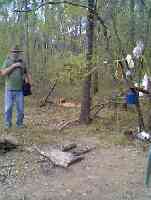


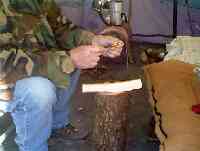
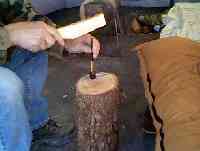
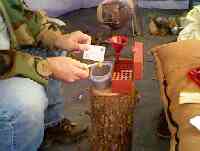
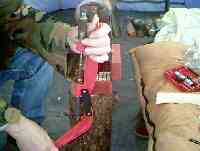
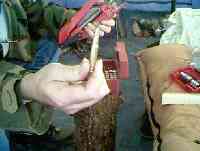





 Here's a drawing of my grandfather and great-grandfather's hog mark. To an open range hog man, it reads: upper slope and under bit in the left ear, swallow fork and under bit in the right ear. Cuts I remember include:
Here's a drawing of my grandfather and great-grandfather's hog mark. To an open range hog man, it reads: upper slope and under bit in the left ear, swallow fork and under bit in the right ear. Cuts I remember include: Here's a photo taken in July, 1999, of an open range, marked sow and her unmarked piglet.
Here's a photo taken in July, 1999, of an open range, marked sow and her unmarked piglet. Little River begins near my hometown of Tullos, under the red star in the map, and flows into Catahoula Lake—which, by the way, Hernando De Soto and his men crossed in circa 1535. They also fought a battle with Indians who lived in what is now Jonesville, shown on the map.
Little River begins near my hometown of Tullos, under the red star in the map, and flows into Catahoula Lake—which, by the way, Hernando De Soto and his men crossed in circa 1535. They also fought a battle with Indians who lived in what is now Jonesville, shown on the map. 